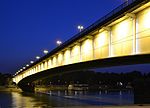Old Sava Bridge

The Old Sava Bridge (Serbian: Стари савски мост, romanized: Stari savski most) is a 430-metre-long (1,410 ft) and 40-metre-wide (130 ft) bridge, crossing the river Sava in Belgrade, Serbia. It is the smallest road bridge in the Serbian capital and is used both for car and tram traffic. The main span between the two pillars of this tied arch bridge is over 157 m (515 ft) in length. Two bus lines and three tram lines of Belgrade public transport use the bridge. Due to its history, the bridge is said to have very important place and role in Belgrade's skyline and memory and is considered by many citizens as one of the city symbols. However, starting in 2016 and 2017, the city administration decided to demolish it and build the new bridge instead to be more "modern" because of the nearby Belgrade Waterfront project. This met with fierce public and experts opposition, with city changing the future of the bridge several times (expansion, upgrade, demolition, relocation on various locations) before claiming that citizens voted online to relocate it on dry land in the Ušće Park, as an "attraction". The reporters and public distanced from the voting, some debunking it as being rigged and unrepresentative.
Excerpt from the Wikipedia article Old Sava Bridge (License: CC BY-SA 3.0, Authors, Images).Old Sava Bridge
Земунски пут, Belgrade Београд (Савски венац) (Savski Venac Urban Municipality)
Geographical coordinates (GPS) Address Nearby Places Show on map
Geographical coordinates (GPS)
| Latitude | Longitude |
|---|---|
| N 44.810833333333 ° | E 20.447777777778 ° |
Address
Стари савски мост
Земунски пут
11000 Belgrade, Београд (Савски венац) (Savski Venac Urban Municipality)
Central Serbia, Serbia
Open on Google Maps










